System Analysis and Design Report: Lilydale Movies Information System
VerifiedAdded on 2023/01/19
|16
|2942
|46
Report
AI Summary
This report presents a comprehensive system analysis and design for Lilydale Movies, a growing movie sales and rental chain. It begins with an executive summary, outlining the need for system analysis and design in implementing a new information system to reduce costs and improve efficiency. The report delves into the organization's background, identifies key business problems such as the need for business automation and performance monitoring, and analyzes functional and non-functional requirements. It includes a detailed data dictionary, process descriptions using pseudocode, and an explanation of techniques used for identifying use cases (user goal, CRUD, and event decomposition). The report then models the current system with an ER diagram, context diagram, Level 0 and Level 1 DFDs, and an event table, along with data fragments. The analysis aims to provide Lilydale Movies with a roadmap for a new information system that supports their expansion and improves operational efficiency.
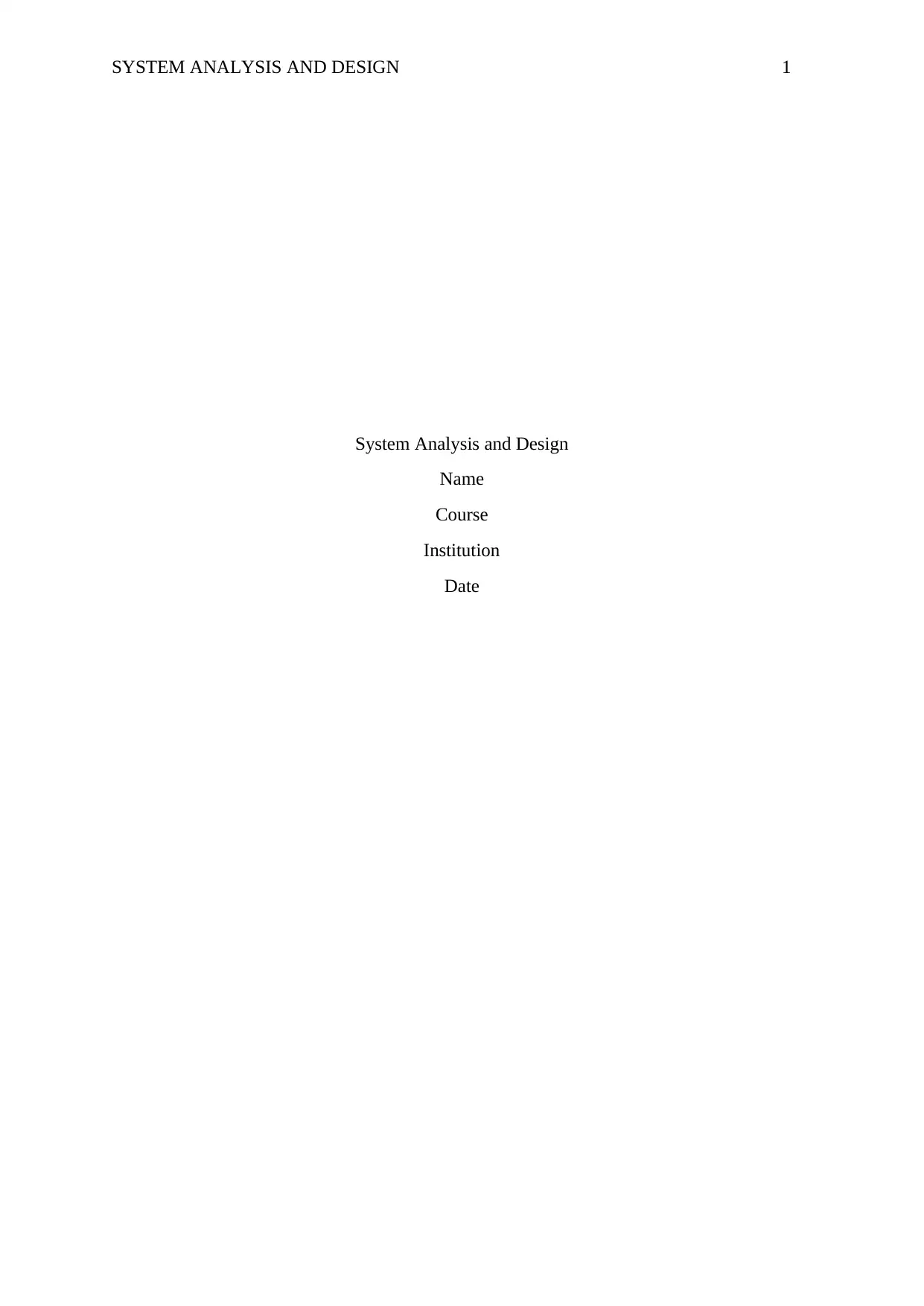
SYSTEM ANALYSIS AND DESIGN 1
System Analysis and Design
Name
Course
Institution
Date
System Analysis and Design
Name
Course
Institution
Date
Paraphrase This Document
Need a fresh take? Get an instant paraphrase of this document with our AI Paraphraser
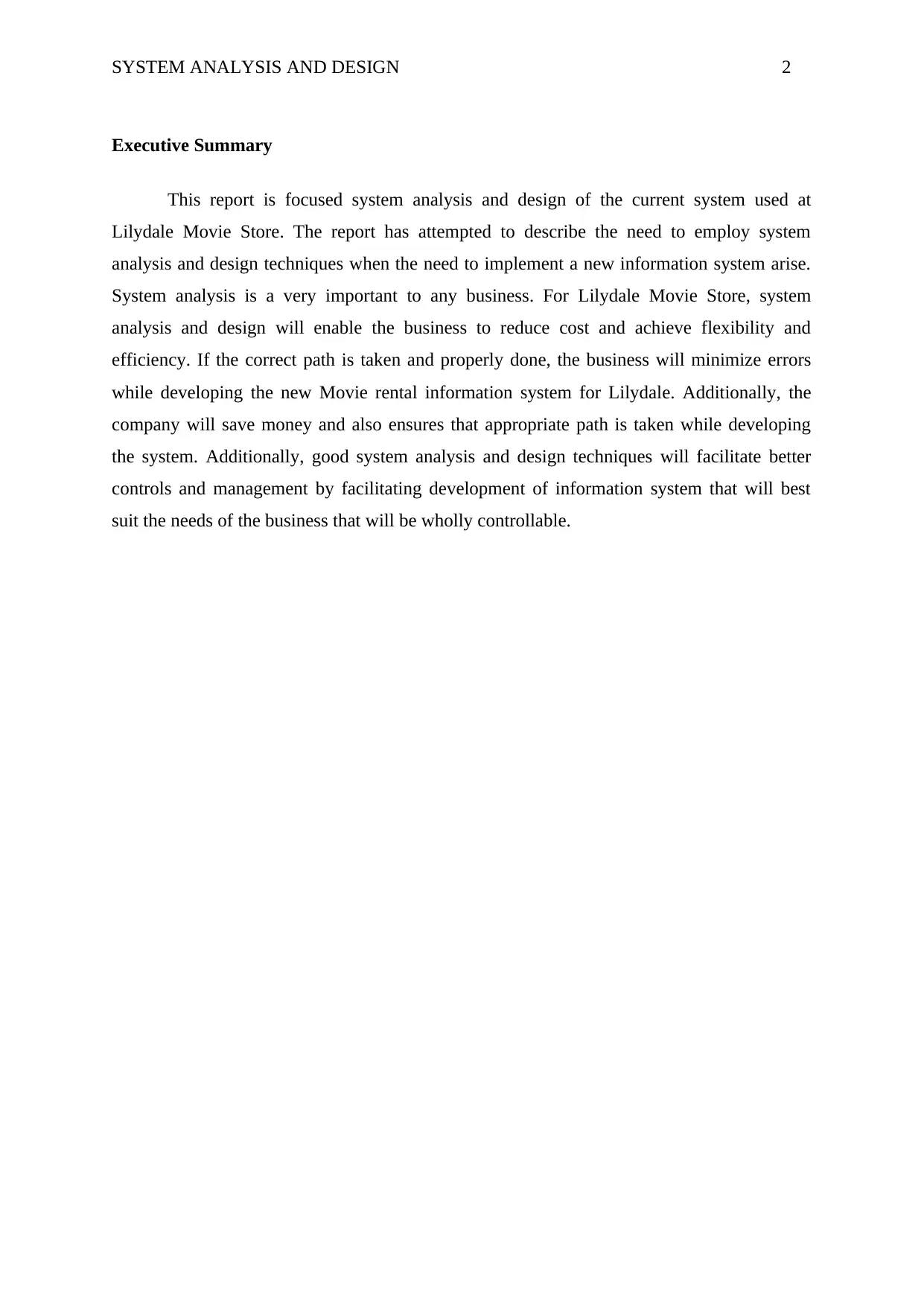
SYSTEM ANALYSIS AND DESIGN 2
Executive Summary
This report is focused system analysis and design of the current system used at
Lilydale Movie Store. The report has attempted to describe the need to employ system
analysis and design techniques when the need to implement a new information system arise.
System analysis is a very important to any business. For Lilydale Movie Store, system
analysis and design will enable the business to reduce cost and achieve flexibility and
efficiency. If the correct path is taken and properly done, the business will minimize errors
while developing the new Movie rental information system for Lilydale. Additionally, the
company will save money and also ensures that appropriate path is taken while developing
the system. Additionally, good system analysis and design techniques will facilitate better
controls and management by facilitating development of information system that will best
suit the needs of the business that will be wholly controllable.
Executive Summary
This report is focused system analysis and design of the current system used at
Lilydale Movie Store. The report has attempted to describe the need to employ system
analysis and design techniques when the need to implement a new information system arise.
System analysis is a very important to any business. For Lilydale Movie Store, system
analysis and design will enable the business to reduce cost and achieve flexibility and
efficiency. If the correct path is taken and properly done, the business will minimize errors
while developing the new Movie rental information system for Lilydale. Additionally, the
company will save money and also ensures that appropriate path is taken while developing
the system. Additionally, good system analysis and design techniques will facilitate better
controls and management by facilitating development of information system that will best
suit the needs of the business that will be wholly controllable.
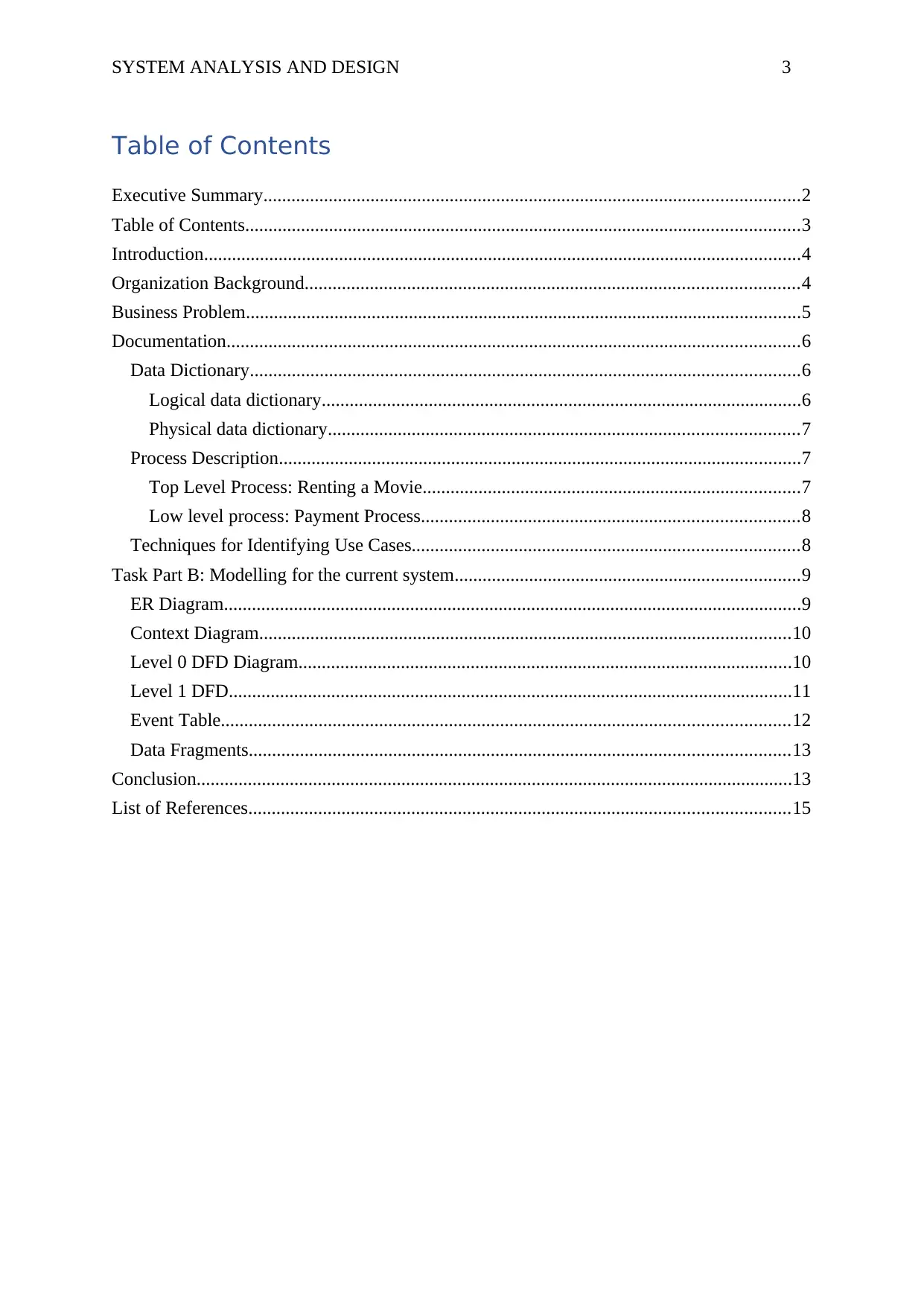
SYSTEM ANALYSIS AND DESIGN 3
Table of Contents
Executive Summary...................................................................................................................2
Table of Contents.......................................................................................................................3
Introduction................................................................................................................................4
Organization Background..........................................................................................................4
Business Problem.......................................................................................................................5
Documentation...........................................................................................................................6
Data Dictionary......................................................................................................................6
Logical data dictionary.......................................................................................................6
Physical data dictionary.....................................................................................................7
Process Description................................................................................................................7
Top Level Process: Renting a Movie.................................................................................7
Low level process: Payment Process.................................................................................8
Techniques for Identifying Use Cases...................................................................................8
Task Part B: Modelling for the current system..........................................................................9
ER Diagram............................................................................................................................9
Context Diagram..................................................................................................................10
Level 0 DFD Diagram..........................................................................................................10
Level 1 DFD.........................................................................................................................11
Event Table..........................................................................................................................12
Data Fragments....................................................................................................................13
Conclusion................................................................................................................................13
List of References....................................................................................................................15
Table of Contents
Executive Summary...................................................................................................................2
Table of Contents.......................................................................................................................3
Introduction................................................................................................................................4
Organization Background..........................................................................................................4
Business Problem.......................................................................................................................5
Documentation...........................................................................................................................6
Data Dictionary......................................................................................................................6
Logical data dictionary.......................................................................................................6
Physical data dictionary.....................................................................................................7
Process Description................................................................................................................7
Top Level Process: Renting a Movie.................................................................................7
Low level process: Payment Process.................................................................................8
Techniques for Identifying Use Cases...................................................................................8
Task Part B: Modelling for the current system..........................................................................9
ER Diagram............................................................................................................................9
Context Diagram..................................................................................................................10
Level 0 DFD Diagram..........................................................................................................10
Level 1 DFD.........................................................................................................................11
Event Table..........................................................................................................................12
Data Fragments....................................................................................................................13
Conclusion................................................................................................................................13
List of References....................................................................................................................15
⊘ This is a preview!⊘
Do you want full access?
Subscribe today to unlock all pages.

Trusted by 1+ million students worldwide
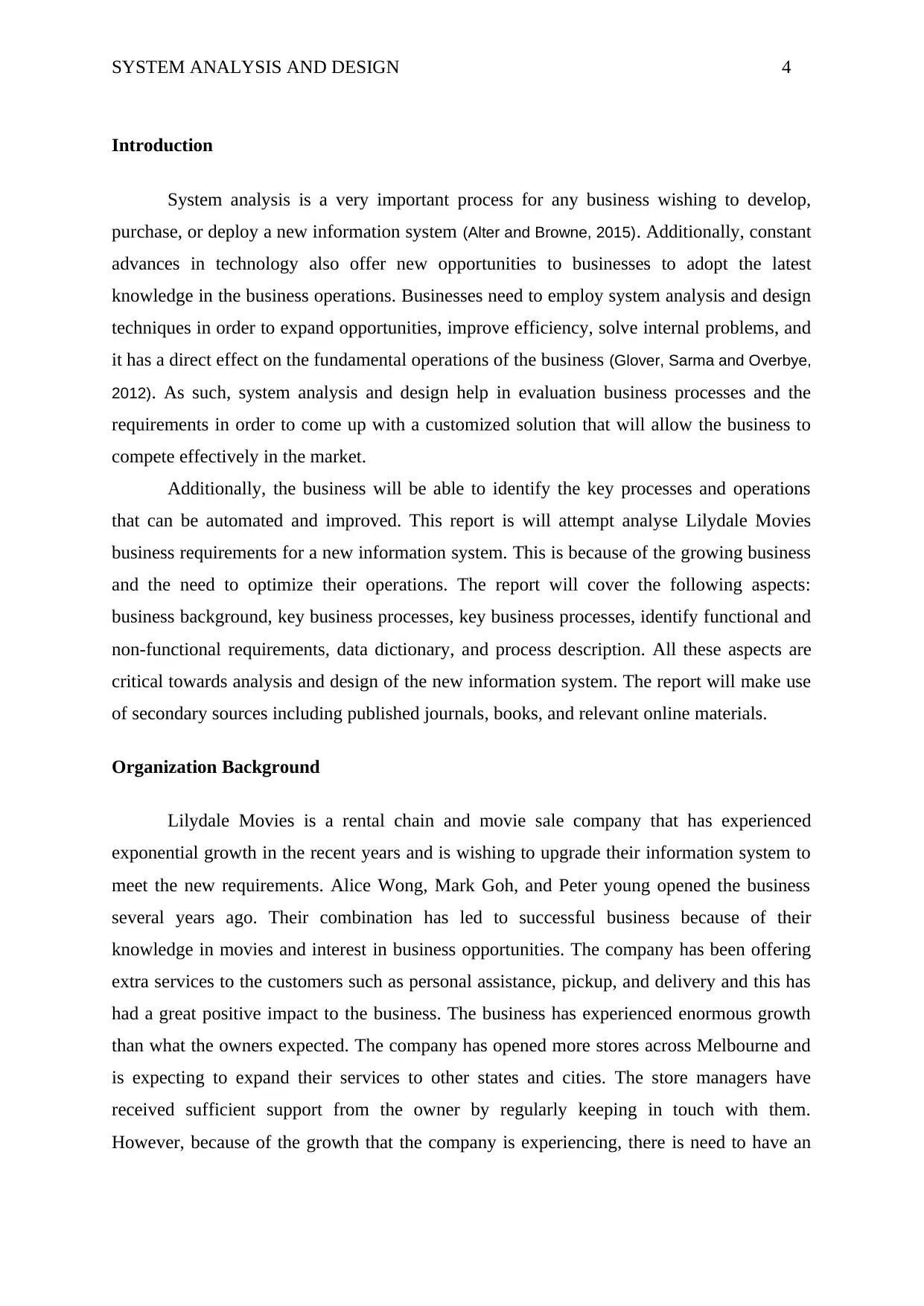
SYSTEM ANALYSIS AND DESIGN 4
Introduction
System analysis is a very important process for any business wishing to develop,
purchase, or deploy a new information system (Alter and Browne, 2015). Additionally, constant
advances in technology also offer new opportunities to businesses to adopt the latest
knowledge in the business operations. Businesses need to employ system analysis and design
techniques in order to expand opportunities, improve efficiency, solve internal problems, and
it has a direct effect on the fundamental operations of the business (Glover, Sarma and Overbye,
2012). As such, system analysis and design help in evaluation business processes and the
requirements in order to come up with a customized solution that will allow the business to
compete effectively in the market.
Additionally, the business will be able to identify the key processes and operations
that can be automated and improved. This report is will attempt analyse Lilydale Movies
business requirements for a new information system. This is because of the growing business
and the need to optimize their operations. The report will cover the following aspects:
business background, key business processes, key business processes, identify functional and
non-functional requirements, data dictionary, and process description. All these aspects are
critical towards analysis and design of the new information system. The report will make use
of secondary sources including published journals, books, and relevant online materials.
Organization Background
Lilydale Movies is a rental chain and movie sale company that has experienced
exponential growth in the recent years and is wishing to upgrade their information system to
meet the new requirements. Alice Wong, Mark Goh, and Peter young opened the business
several years ago. Their combination has led to successful business because of their
knowledge in movies and interest in business opportunities. The company has been offering
extra services to the customers such as personal assistance, pickup, and delivery and this has
had a great positive impact to the business. The business has experienced enormous growth
than what the owners expected. The company has opened more stores across Melbourne and
is expecting to expand their services to other states and cities. The store managers have
received sufficient support from the owner by regularly keeping in touch with them.
However, because of the growth that the company is experiencing, there is need to have an
Introduction
System analysis is a very important process for any business wishing to develop,
purchase, or deploy a new information system (Alter and Browne, 2015). Additionally, constant
advances in technology also offer new opportunities to businesses to adopt the latest
knowledge in the business operations. Businesses need to employ system analysis and design
techniques in order to expand opportunities, improve efficiency, solve internal problems, and
it has a direct effect on the fundamental operations of the business (Glover, Sarma and Overbye,
2012). As such, system analysis and design help in evaluation business processes and the
requirements in order to come up with a customized solution that will allow the business to
compete effectively in the market.
Additionally, the business will be able to identify the key processes and operations
that can be automated and improved. This report is will attempt analyse Lilydale Movies
business requirements for a new information system. This is because of the growing business
and the need to optimize their operations. The report will cover the following aspects:
business background, key business processes, key business processes, identify functional and
non-functional requirements, data dictionary, and process description. All these aspects are
critical towards analysis and design of the new information system. The report will make use
of secondary sources including published journals, books, and relevant online materials.
Organization Background
Lilydale Movies is a rental chain and movie sale company that has experienced
exponential growth in the recent years and is wishing to upgrade their information system to
meet the new requirements. Alice Wong, Mark Goh, and Peter young opened the business
several years ago. Their combination has led to successful business because of their
knowledge in movies and interest in business opportunities. The company has been offering
extra services to the customers such as personal assistance, pickup, and delivery and this has
had a great positive impact to the business. The business has experienced enormous growth
than what the owners expected. The company has opened more stores across Melbourne and
is expecting to expand their services to other states and cities. The store managers have
received sufficient support from the owner by regularly keeping in touch with them.
However, because of the growth that the company is experiencing, there is need to have an
Paraphrase This Document
Need a fresh take? Get an instant paraphrase of this document with our AI Paraphraser
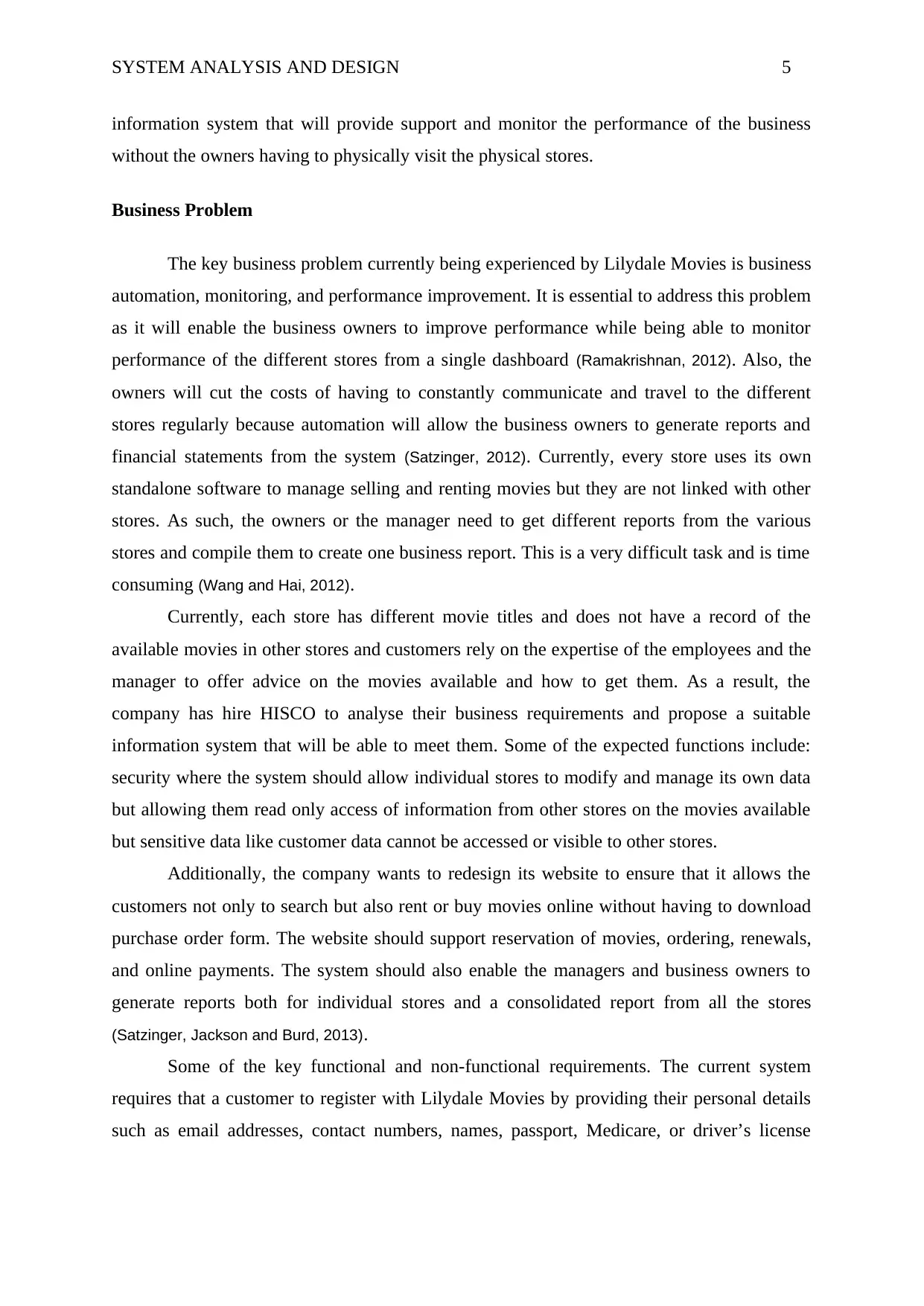
SYSTEM ANALYSIS AND DESIGN 5
information system that will provide support and monitor the performance of the business
without the owners having to physically visit the physical stores.
Business Problem
The key business problem currently being experienced by Lilydale Movies is business
automation, monitoring, and performance improvement. It is essential to address this problem
as it will enable the business owners to improve performance while being able to monitor
performance of the different stores from a single dashboard (Ramakrishnan, 2012). Also, the
owners will cut the costs of having to constantly communicate and travel to the different
stores regularly because automation will allow the business owners to generate reports and
financial statements from the system (Satzinger, 2012). Currently, every store uses its own
standalone software to manage selling and renting movies but they are not linked with other
stores. As such, the owners or the manager need to get different reports from the various
stores and compile them to create one business report. This is a very difficult task and is time
consuming (Wang and Hai, 2012).
Currently, each store has different movie titles and does not have a record of the
available movies in other stores and customers rely on the expertise of the employees and the
manager to offer advice on the movies available and how to get them. As a result, the
company has hire HISCO to analyse their business requirements and propose a suitable
information system that will be able to meet them. Some of the expected functions include:
security where the system should allow individual stores to modify and manage its own data
but allowing them read only access of information from other stores on the movies available
but sensitive data like customer data cannot be accessed or visible to other stores.
Additionally, the company wants to redesign its website to ensure that it allows the
customers not only to search but also rent or buy movies online without having to download
purchase order form. The website should support reservation of movies, ordering, renewals,
and online payments. The system should also enable the managers and business owners to
generate reports both for individual stores and a consolidated report from all the stores
(Satzinger, Jackson and Burd, 2013).
Some of the key functional and non-functional requirements. The current system
requires that a customer to register with Lilydale Movies by providing their personal details
such as email addresses, contact numbers, names, passport, Medicare, or driver’s license
information system that will provide support and monitor the performance of the business
without the owners having to physically visit the physical stores.
Business Problem
The key business problem currently being experienced by Lilydale Movies is business
automation, monitoring, and performance improvement. It is essential to address this problem
as it will enable the business owners to improve performance while being able to monitor
performance of the different stores from a single dashboard (Ramakrishnan, 2012). Also, the
owners will cut the costs of having to constantly communicate and travel to the different
stores regularly because automation will allow the business owners to generate reports and
financial statements from the system (Satzinger, 2012). Currently, every store uses its own
standalone software to manage selling and renting movies but they are not linked with other
stores. As such, the owners or the manager need to get different reports from the various
stores and compile them to create one business report. This is a very difficult task and is time
consuming (Wang and Hai, 2012).
Currently, each store has different movie titles and does not have a record of the
available movies in other stores and customers rely on the expertise of the employees and the
manager to offer advice on the movies available and how to get them. As a result, the
company has hire HISCO to analyse their business requirements and propose a suitable
information system that will be able to meet them. Some of the expected functions include:
security where the system should allow individual stores to modify and manage its own data
but allowing them read only access of information from other stores on the movies available
but sensitive data like customer data cannot be accessed or visible to other stores.
Additionally, the company wants to redesign its website to ensure that it allows the
customers not only to search but also rent or buy movies online without having to download
purchase order form. The website should support reservation of movies, ordering, renewals,
and online payments. The system should also enable the managers and business owners to
generate reports both for individual stores and a consolidated report from all the stores
(Satzinger, Jackson and Burd, 2013).
Some of the key functional and non-functional requirements. The current system
requires that a customer to register with Lilydale Movies by providing their personal details
such as email addresses, contact numbers, names, passport, Medicare, or driver’s license
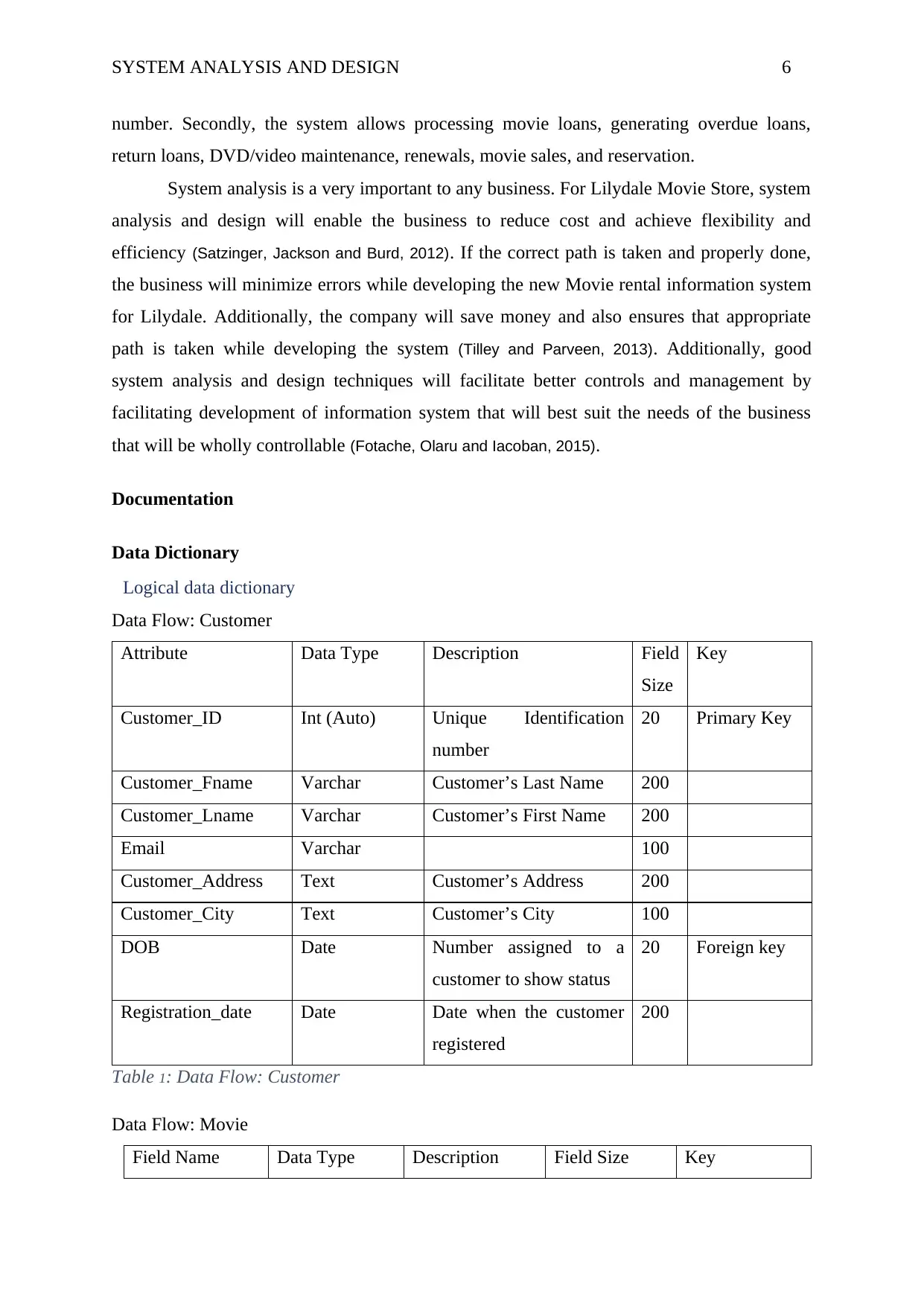
SYSTEM ANALYSIS AND DESIGN 6
number. Secondly, the system allows processing movie loans, generating overdue loans,
return loans, DVD/video maintenance, renewals, movie sales, and reservation.
System analysis is a very important to any business. For Lilydale Movie Store, system
analysis and design will enable the business to reduce cost and achieve flexibility and
efficiency (Satzinger, Jackson and Burd, 2012). If the correct path is taken and properly done,
the business will minimize errors while developing the new Movie rental information system
for Lilydale. Additionally, the company will save money and also ensures that appropriate
path is taken while developing the system (Tilley and Parveen, 2013). Additionally, good
system analysis and design techniques will facilitate better controls and management by
facilitating development of information system that will best suit the needs of the business
that will be wholly controllable (Fotache, Olaru and Iacoban, 2015).
Documentation
Data Dictionary
Logical data dictionary
Data Flow: Customer
Attribute Data Type Description Field
Size
Key
Customer_ID Int (Auto) Unique Identification
number
20 Primary Key
Customer_Fname Varchar Customer’s Last Name 200
Customer_Lname Varchar Customer’s First Name 200
Email Varchar 100
Customer_Address Text Customer’s Address 200
Customer_City Text Customer’s City 100
DOB Date Number assigned to a
customer to show status
20 Foreign key
Registration_date Date Date when the customer
registered
200
Table 1: Data Flow: Customer
Data Flow: Movie
Field Name Data Type Description Field Size Key
number. Secondly, the system allows processing movie loans, generating overdue loans,
return loans, DVD/video maintenance, renewals, movie sales, and reservation.
System analysis is a very important to any business. For Lilydale Movie Store, system
analysis and design will enable the business to reduce cost and achieve flexibility and
efficiency (Satzinger, Jackson and Burd, 2012). If the correct path is taken and properly done,
the business will minimize errors while developing the new Movie rental information system
for Lilydale. Additionally, the company will save money and also ensures that appropriate
path is taken while developing the system (Tilley and Parveen, 2013). Additionally, good
system analysis and design techniques will facilitate better controls and management by
facilitating development of information system that will best suit the needs of the business
that will be wholly controllable (Fotache, Olaru and Iacoban, 2015).
Documentation
Data Dictionary
Logical data dictionary
Data Flow: Customer
Attribute Data Type Description Field
Size
Key
Customer_ID Int (Auto) Unique Identification
number
20 Primary Key
Customer_Fname Varchar Customer’s Last Name 200
Customer_Lname Varchar Customer’s First Name 200
Email Varchar 100
Customer_Address Text Customer’s Address 200
Customer_City Text Customer’s City 100
DOB Date Number assigned to a
customer to show status
20 Foreign key
Registration_date Date Date when the customer
registered
200
Table 1: Data Flow: Customer
Data Flow: Movie
Field Name Data Type Description Field Size Key
⊘ This is a preview!⊘
Do you want full access?
Subscribe today to unlock all pages.

Trusted by 1+ million students worldwide
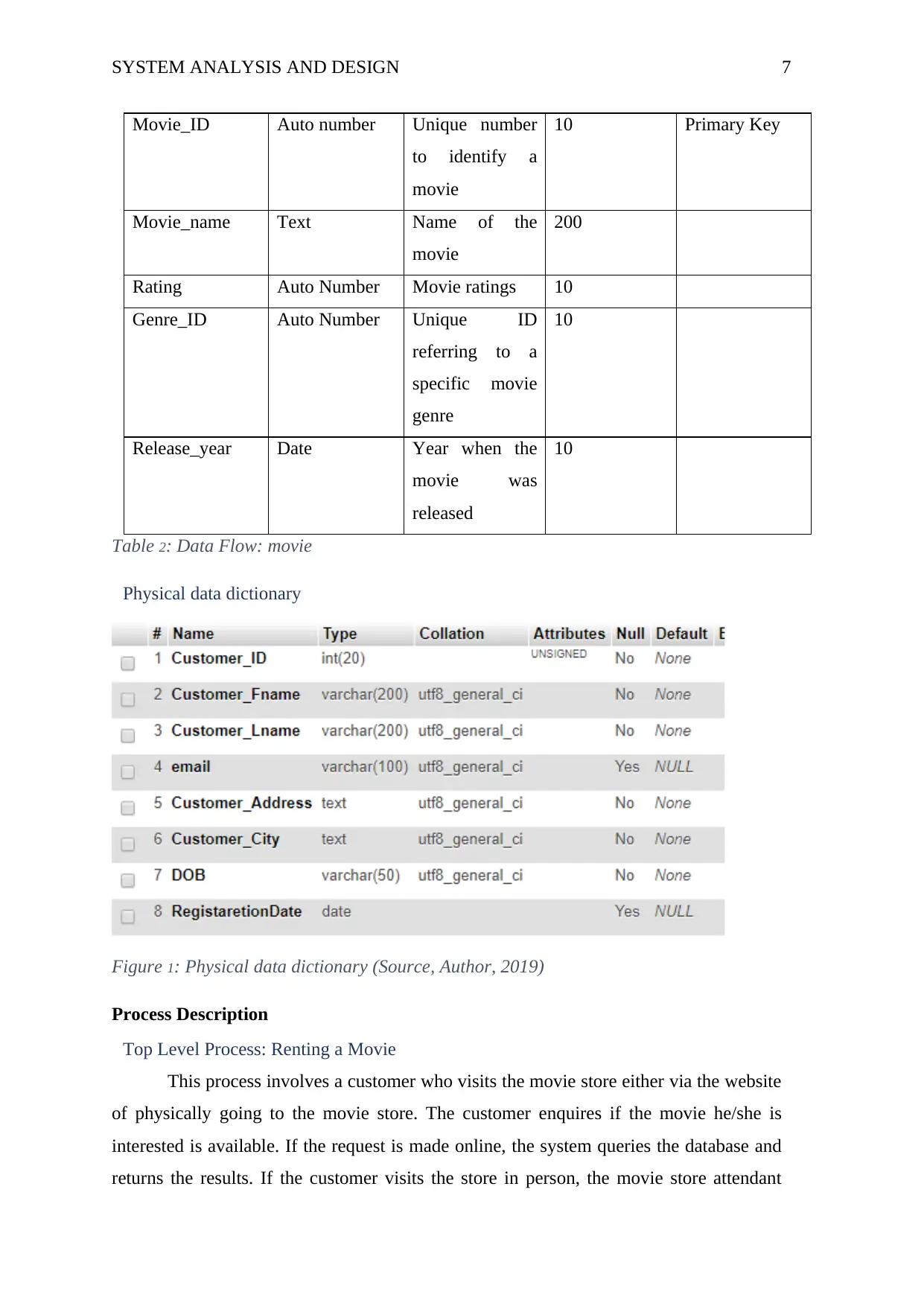
SYSTEM ANALYSIS AND DESIGN 7
Movie_ID Auto number Unique number
to identify a
movie
10 Primary Key
Movie_name Text Name of the
movie
200
Rating Auto Number Movie ratings 10
Genre_ID Auto Number Unique ID
referring to a
specific movie
genre
10
Release_year Date Year when the
movie was
released
10
Table 2: Data Flow: movie
Physical data dictionary
Figure 1: Physical data dictionary (Source, Author, 2019)
Process Description
Top Level Process: Renting a Movie
This process involves a customer who visits the movie store either via the website
of physically going to the movie store. The customer enquires if the movie he/she is
interested is available. If the request is made online, the system queries the database and
returns the results. If the customer visits the store in person, the movie store attendant
Movie_ID Auto number Unique number
to identify a
movie
10 Primary Key
Movie_name Text Name of the
movie
200
Rating Auto Number Movie ratings 10
Genre_ID Auto Number Unique ID
referring to a
specific movie
genre
10
Release_year Date Year when the
movie was
released
10
Table 2: Data Flow: movie
Physical data dictionary
Figure 1: Physical data dictionary (Source, Author, 2019)
Process Description
Top Level Process: Renting a Movie
This process involves a customer who visits the movie store either via the website
of physically going to the movie store. The customer enquires if the movie he/she is
interested is available. If the request is made online, the system queries the database and
returns the results. If the customer visits the store in person, the movie store attendant
Paraphrase This Document
Need a fresh take? Get an instant paraphrase of this document with our AI Paraphraser
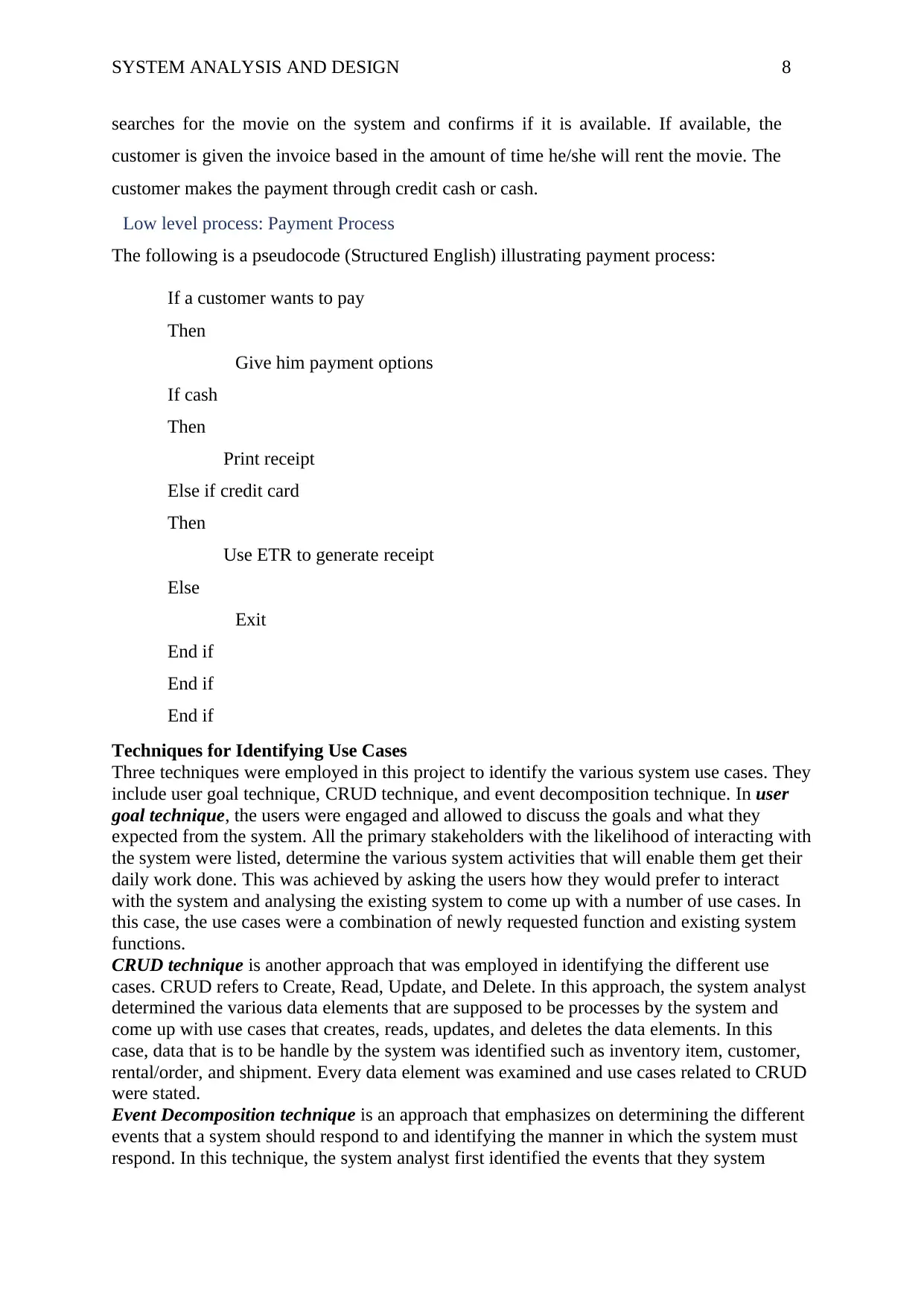
SYSTEM ANALYSIS AND DESIGN 8
searches for the movie on the system and confirms if it is available. If available, the
customer is given the invoice based in the amount of time he/she will rent the movie. The
customer makes the payment through credit cash or cash.
Low level process: Payment Process
The following is a pseudocode (Structured English) illustrating payment process:
If a customer wants to pay
Then
Give him payment options
If cash
Then
Print receipt
Else if credit card
Then
Use ETR to generate receipt
Else
Exit
End if
End if
End if
Techniques for Identifying Use Cases
Three techniques were employed in this project to identify the various system use cases. They
include user goal technique, CRUD technique, and event decomposition technique. In user
goal technique, the users were engaged and allowed to discuss the goals and what they
expected from the system. All the primary stakeholders with the likelihood of interacting with
the system were listed, determine the various system activities that will enable them get their
daily work done. This was achieved by asking the users how they would prefer to interact
with the system and analysing the existing system to come up with a number of use cases. In
this case, the use cases were a combination of newly requested function and existing system
functions.
CRUD technique is another approach that was employed in identifying the different use
cases. CRUD refers to Create, Read, Update, and Delete. In this approach, the system analyst
determined the various data elements that are supposed to be processes by the system and
come up with use cases that creates, reads, updates, and deletes the data elements. In this
case, data that is to be handle by the system was identified such as inventory item, customer,
rental/order, and shipment. Every data element was examined and use cases related to CRUD
were stated.
Event Decomposition technique is an approach that emphasizes on determining the different
events that a system should respond to and identifying the manner in which the system must
respond. In this technique, the system analyst first identified the events that they system
searches for the movie on the system and confirms if it is available. If available, the
customer is given the invoice based in the amount of time he/she will rent the movie. The
customer makes the payment through credit cash or cash.
Low level process: Payment Process
The following is a pseudocode (Structured English) illustrating payment process:
If a customer wants to pay
Then
Give him payment options
If cash
Then
Print receipt
Else if credit card
Then
Use ETR to generate receipt
Else
Exit
End if
End if
End if
Techniques for Identifying Use Cases
Three techniques were employed in this project to identify the various system use cases. They
include user goal technique, CRUD technique, and event decomposition technique. In user
goal technique, the users were engaged and allowed to discuss the goals and what they
expected from the system. All the primary stakeholders with the likelihood of interacting with
the system were listed, determine the various system activities that will enable them get their
daily work done. This was achieved by asking the users how they would prefer to interact
with the system and analysing the existing system to come up with a number of use cases. In
this case, the use cases were a combination of newly requested function and existing system
functions.
CRUD technique is another approach that was employed in identifying the different use
cases. CRUD refers to Create, Read, Update, and Delete. In this approach, the system analyst
determined the various data elements that are supposed to be processes by the system and
come up with use cases that creates, reads, updates, and deletes the data elements. In this
case, data that is to be handle by the system was identified such as inventory item, customer,
rental/order, and shipment. Every data element was examined and use cases related to CRUD
were stated.
Event Decomposition technique is an approach that emphasizes on determining the different
events that a system should respond to and identifying the manner in which the system must
respond. In this technique, the system analyst first identified the events that they system
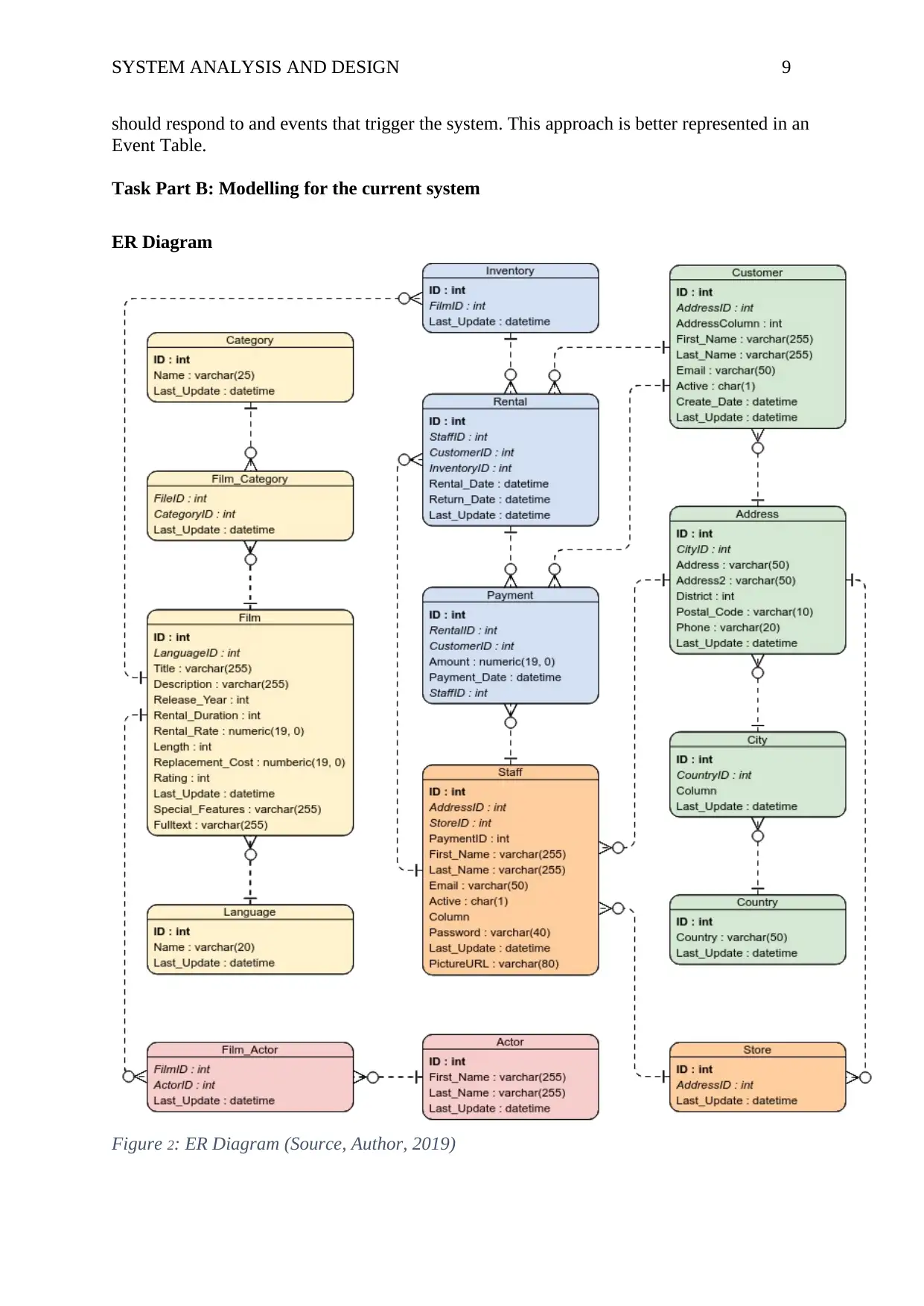
SYSTEM ANALYSIS AND DESIGN 9
should respond to and events that trigger the system. This approach is better represented in an
Event Table.
Task Part B: Modelling for the current system
ER Diagram
Figure 2: ER Diagram (Source, Author, 2019)
should respond to and events that trigger the system. This approach is better represented in an
Event Table.
Task Part B: Modelling for the current system
ER Diagram
Figure 2: ER Diagram (Source, Author, 2019)
⊘ This is a preview!⊘
Do you want full access?
Subscribe today to unlock all pages.

Trusted by 1+ million students worldwide
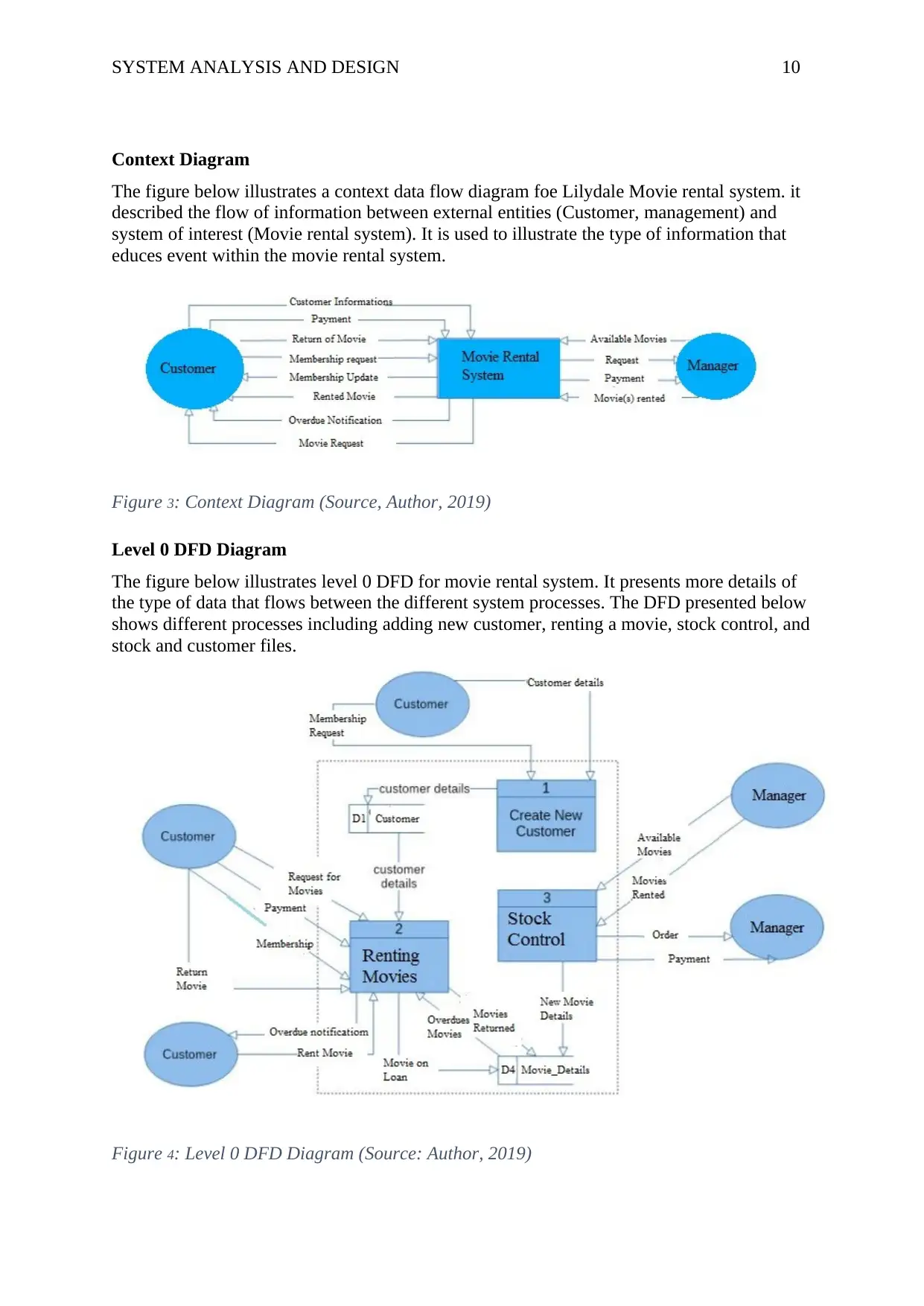
SYSTEM ANALYSIS AND DESIGN 10
Context Diagram
The figure below illustrates a context data flow diagram foe Lilydale Movie rental system. it
described the flow of information between external entities (Customer, management) and
system of interest (Movie rental system). It is used to illustrate the type of information that
educes event within the movie rental system.
Figure 3: Context Diagram (Source, Author, 2019)
Level 0 DFD Diagram
The figure below illustrates level 0 DFD for movie rental system. It presents more details of
the type of data that flows between the different system processes. The DFD presented below
shows different processes including adding new customer, renting a movie, stock control, and
stock and customer files.
Figure 4: Level 0 DFD Diagram (Source: Author, 2019)
Context Diagram
The figure below illustrates a context data flow diagram foe Lilydale Movie rental system. it
described the flow of information between external entities (Customer, management) and
system of interest (Movie rental system). It is used to illustrate the type of information that
educes event within the movie rental system.
Figure 3: Context Diagram (Source, Author, 2019)
Level 0 DFD Diagram
The figure below illustrates level 0 DFD for movie rental system. It presents more details of
the type of data that flows between the different system processes. The DFD presented below
shows different processes including adding new customer, renting a movie, stock control, and
stock and customer files.
Figure 4: Level 0 DFD Diagram (Source: Author, 2019)
Paraphrase This Document
Need a fresh take? Get an instant paraphrase of this document with our AI Paraphraser
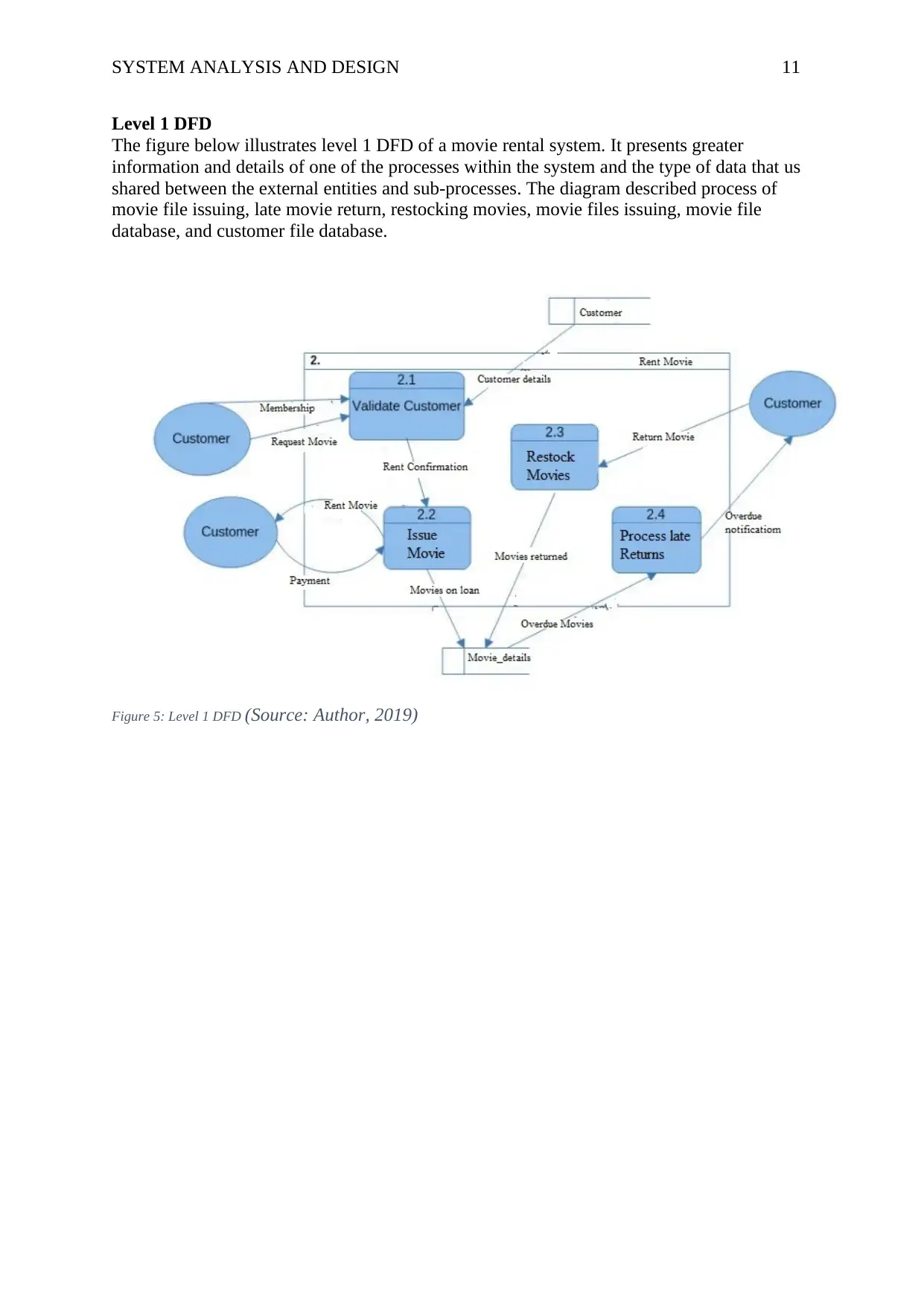
SYSTEM ANALYSIS AND DESIGN 11
Level 1 DFD
The figure below illustrates level 1 DFD of a movie rental system. It presents greater
information and details of one of the processes within the system and the type of data that us
shared between the external entities and sub-processes. The diagram described process of
movie file issuing, late movie return, restocking movies, movie files issuing, movie file
database, and customer file database.
Figure 5: Level 1 DFD (Source: Author, 2019)
Level 1 DFD
The figure below illustrates level 1 DFD of a movie rental system. It presents greater
information and details of one of the processes within the system and the type of data that us
shared between the external entities and sub-processes. The diagram described process of
movie file issuing, late movie return, restocking movies, movie files issuing, movie file
database, and customer file database.
Figure 5: Level 1 DFD (Source: Author, 2019)
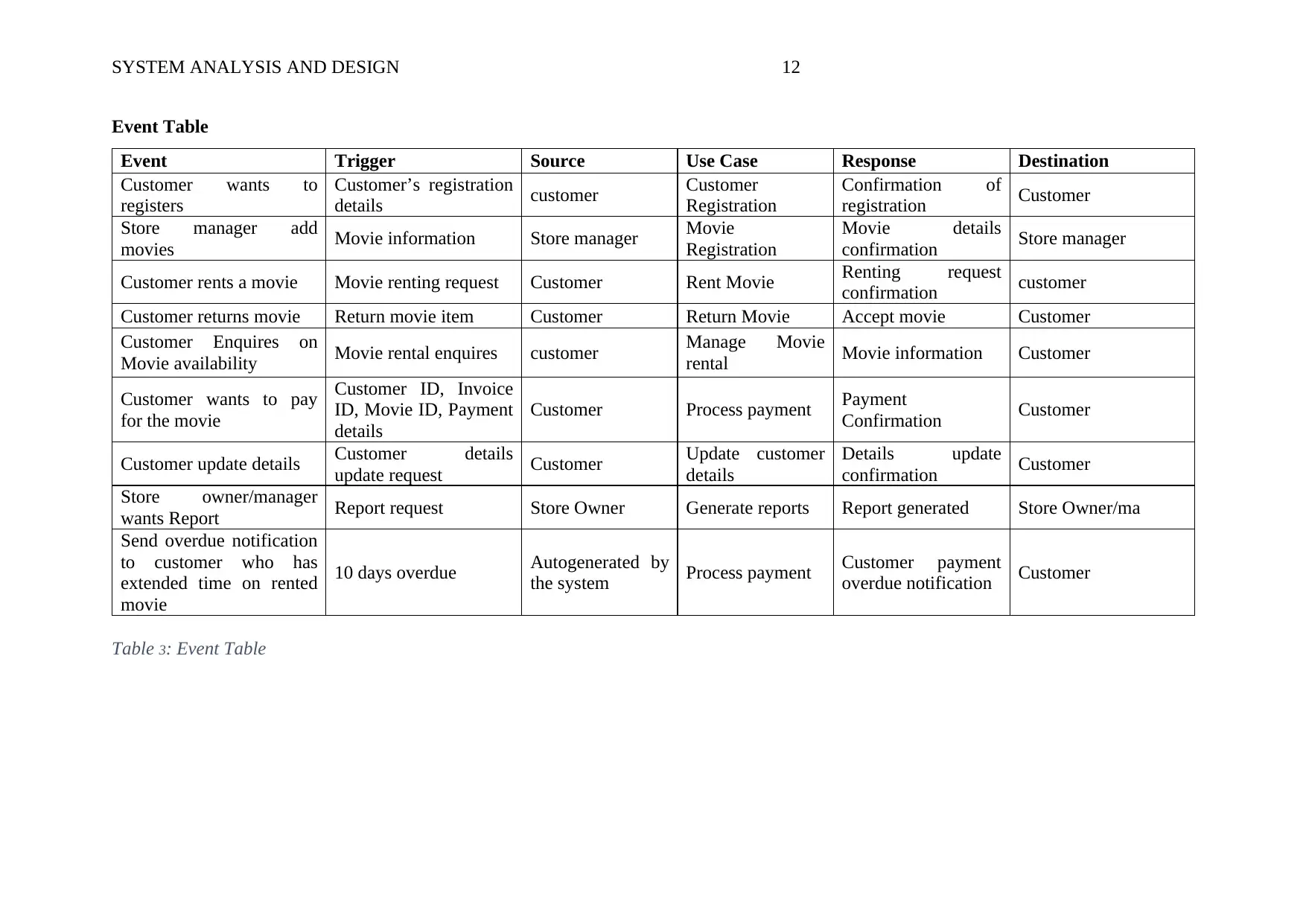
SYSTEM ANALYSIS AND DESIGN 12
Event Table
Event Trigger Source Use Case Response Destination
Customer wants to
registers
Customer’s registration
details customer Customer
Registration
Confirmation of
registration Customer
Store manager add
movies Movie information Store manager Movie
Registration
Movie details
confirmation Store manager
Customer rents a movie Movie renting request Customer Rent Movie Renting request
confirmation customer
Customer returns movie Return movie item Customer Return Movie Accept movie Customer
Customer Enquires on
Movie availability Movie rental enquires customer Manage Movie
rental Movie information Customer
Customer wants to pay
for the movie
Customer ID, Invoice
ID, Movie ID, Payment
details
Customer Process payment Payment
Confirmation Customer
Customer update details Customer details
update request Customer Update customer
details
Details update
confirmation Customer
Store owner/manager
wants Report Report request Store Owner Generate reports Report generated Store Owner/ma
Send overdue notification
to customer who has
extended time on rented
movie
10 days overdue Autogenerated by
the system Process payment Customer payment
overdue notification Customer
Table 3: Event Table
Event Table
Event Trigger Source Use Case Response Destination
Customer wants to
registers
Customer’s registration
details customer Customer
Registration
Confirmation of
registration Customer
Store manager add
movies Movie information Store manager Movie
Registration
Movie details
confirmation Store manager
Customer rents a movie Movie renting request Customer Rent Movie Renting request
confirmation customer
Customer returns movie Return movie item Customer Return Movie Accept movie Customer
Customer Enquires on
Movie availability Movie rental enquires customer Manage Movie
rental Movie information Customer
Customer wants to pay
for the movie
Customer ID, Invoice
ID, Movie ID, Payment
details
Customer Process payment Payment
Confirmation Customer
Customer update details Customer details
update request Customer Update customer
details
Details update
confirmation Customer
Store owner/manager
wants Report Report request Store Owner Generate reports Report generated Store Owner/ma
Send overdue notification
to customer who has
extended time on rented
movie
10 days overdue Autogenerated by
the system Process payment Customer payment
overdue notification Customer
Table 3: Event Table
⊘ This is a preview!⊘
Do you want full access?
Subscribe today to unlock all pages.

Trusted by 1+ million students worldwide
1 out of 16
Related Documents
Your All-in-One AI-Powered Toolkit for Academic Success.
+13062052269
info@desklib.com
Available 24*7 on WhatsApp / Email
![[object Object]](/_next/static/media/star-bottom.7253800d.svg)
Unlock your academic potential
Copyright © 2020–2025 A2Z Services. All Rights Reserved. Developed and managed by ZUCOL.





